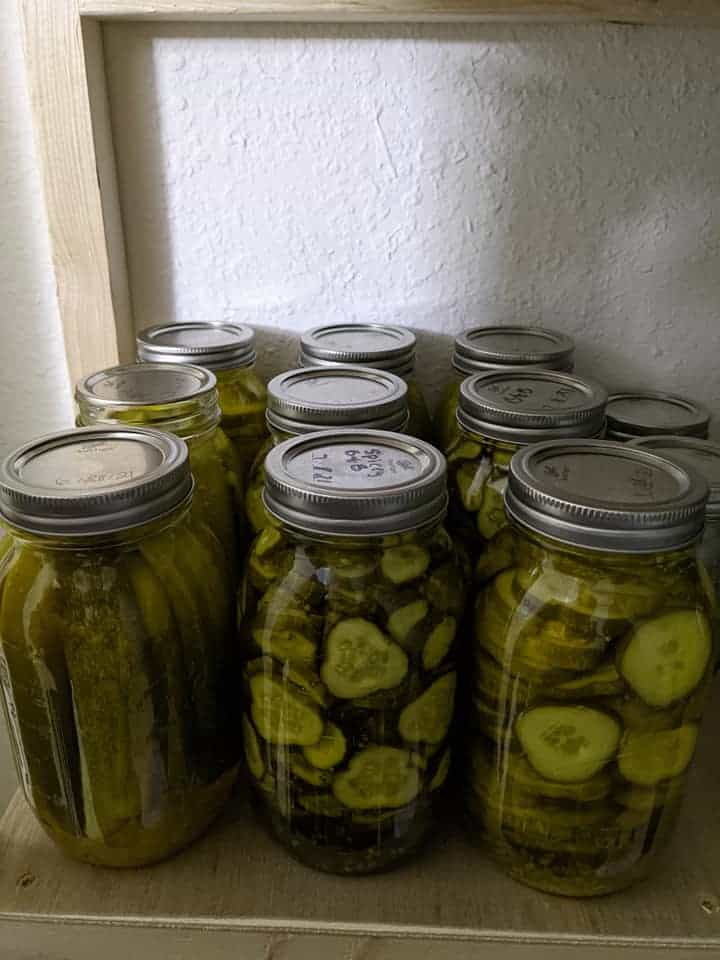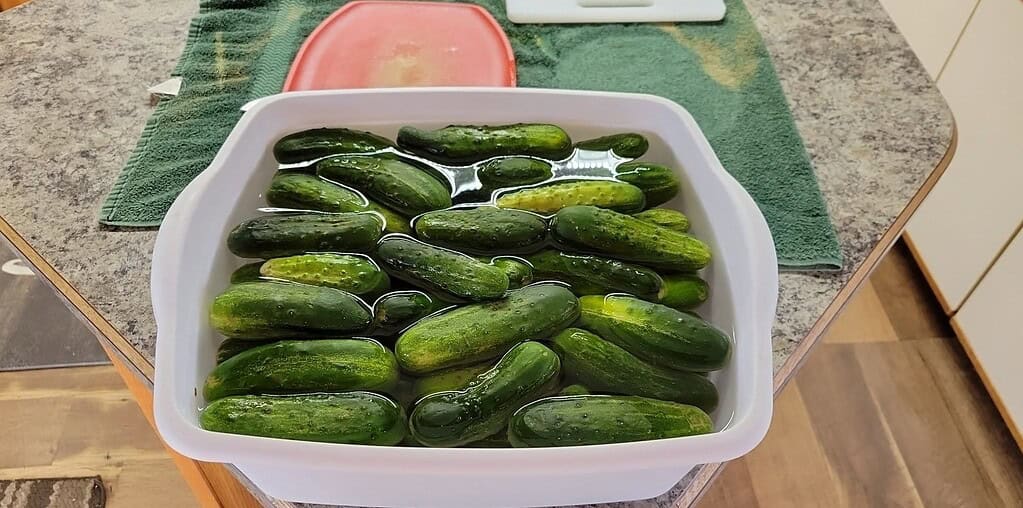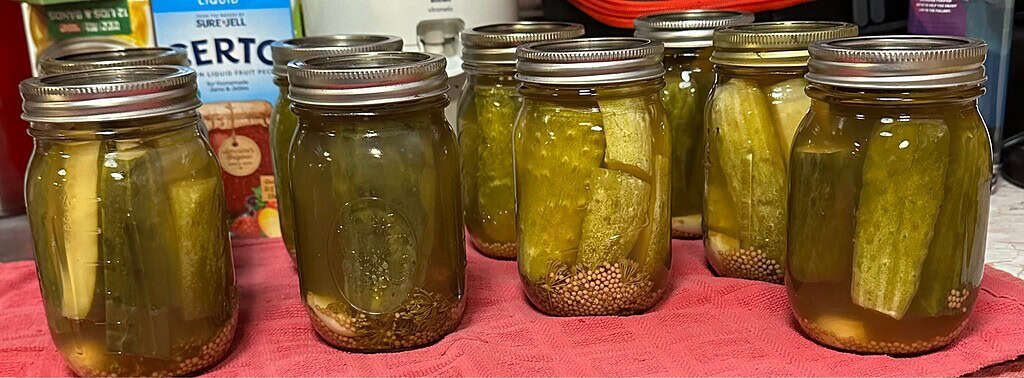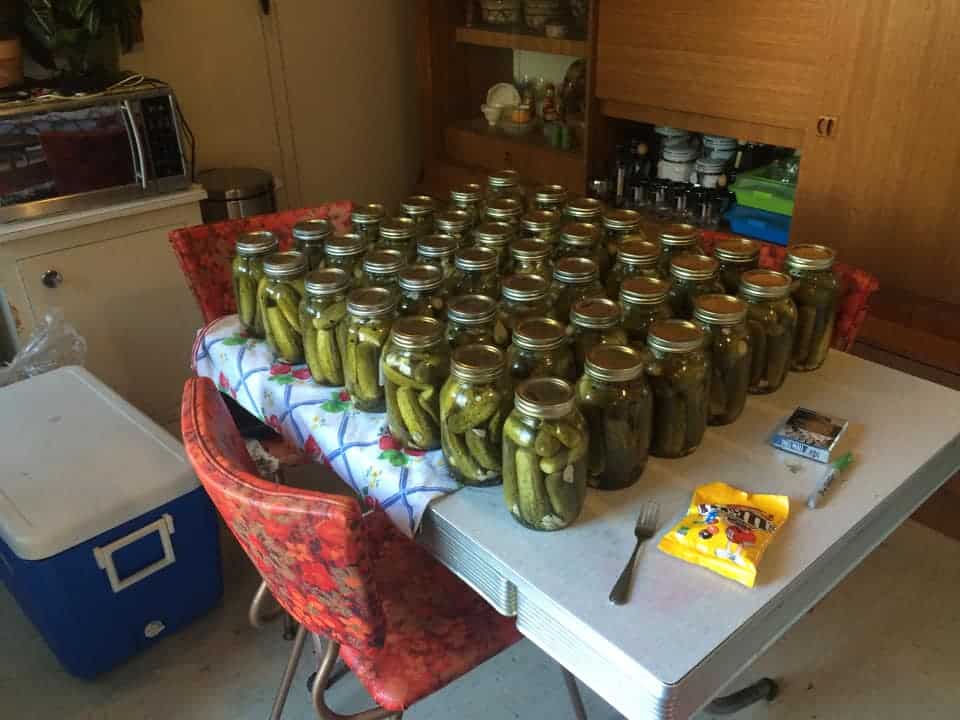There’s nothing quite like the crisp snap of a homemade dill pickle.
This recipe is a tested fresh-pack method, meaning the cucumbers are preserved with a vinegar brine and then processed in a boiling-water canner so they can be stored safely on the shelf.
With firm cucumbers, the right ratio of vinegar, salt, and spices, and careful processing, you can stock your pantry with jars of tangy pickles that last for months.
What Are Pickled Cucumbers?

Pickled cucumbers are fresh cucumbers transformed by soaking in a salty, tangy brine.
The vinegar provides the distinctive flavor while ensuring safe preservation, and the dill and spices add layers of aroma and taste.
Love Pickling? This is part of my How to Pickle Everything series! Check out more recipes:
- Quick Pickled Radishes Recipe
- Easy Pickled Beets Recipe
- Homemade Pickled Okra Recipe
- How to Make Pickled Cabbage (Only 20 Minutes!)
- How to Make Pickled Jalapeños at Home
- Pickled Garlic Recipe
- Easy Pickled Banana Peppers Recipe
- Quick Pickled Carrots Recipe
- How to Make Pickled Asparagus at Home
- How to Make Pickled Ginger (Gari) at Home
- How to Make Pickled Cauliflower
- Crisp Pickled Green Beans Recipe
- Homemade Pickled Eggs with Beets
- Easy Pickled Cherry Tomatoes (No Canning Needed)
Because this recipe uses a tested canning process, the finished jars can be stored in a cool, dark place for up to a year without refrigeration until they are opened.
What You’ll Need to Make Pickled Cucumbers (7–9 Pints)

- 8 lbs pickling cucumbers (3–5 inches long)
- 2 gallons water (for brining step)
- 1¼ cups canning or pickling salt (divided use)
- 1½ quarts white distilled vinegar (5% acidity)
- ¼ cup sugar
- 2 quarts water (for pickling solution)
- 2 tbsp whole mixed pickling spice (tied in a clean cloth bag)
- About 3 tbsp whole mustard seed (use 1 tsp per pint jar)
- About 14 heads of fresh dill (1½ heads per pint jar)
– or – 4½ tbsp dill seed (1½ tsp per pint jar)
For the best and safest results, always use vinegar with 5% acidity, canning or pickling salt (not table salt), and firm pickling cucumbers.
Follow the processing times exactly as written, adjusting for your elevation.
This recipe has been tested for safety, so keeping the proportions and instructions the same ensures reliable results.
Equipment for Making Pickled Cucumbers
- Boiling-water canner with rack and lid
- Canning jars (pint or quart, with new lids and rings)
- Large nonreactive pot for brine
- Sharp knife and cutting board
- Clean cloth for spice bag
- Tongs or jar lifter
How to Make Pickled Cucumbers in 5 Steps

Crunchy, tangy, and full of flavor – dill pickles are a classic for a reason.
With this step-by-step method, you can create a reliable, shelf-stable batch that’s every bit as satisfying as your favorite store-bought pickles – only better.
Let’s get started!
1. Preparing the Cucumbers
Wash the cucumbers thoroughly under cool running water.
Trim a thin slice (about 1/16 of an inch) from the blossom end of each cucumber, as this end contains enzymes that can soften the pickles during storage.
Leave about a quarter-inch of stem attached to help the cucumbers hold their shape once packed into jars.
2. Brine the Cucumbers
Dissolve three-quarters of a cup of pickling salt in two gallons of water.
Pour the brine over the cucumbers in a large container, making sure they are fully covered, and let them soak for twelve hours at a cool room temperature.
This step helps firm the cucumbers and improve texture.
After twelve hours, drain the cucumbers thoroughly.
3. Make the Pickling Solution
In a large nonreactive pot, combine the vinegar, the remaining half-cup of salt, the sugar, and two quarts of fresh water.
Place the mixed pickling spices into a clean white cloth or spice bag, tie it securely, and add it to the pot. Heat the mixture to a boil, stirring occasionally to dissolve the salt and sugar completely.
The boiling solution will serve as the liquid that both flavors and preserves the cucumbers.
4. Pack the Jars
Working with clean, prepared jars, place one teaspoon of mustard seed and about one and a half heads of fresh dill (or one and a half teaspoons of dill seed) into each pint jar.
Pack the drained cucumbers firmly into the jars, arranging them so they fit snugly but without crushing.
Once the jars are filled, pour the boiling pickling solution over the cucumbers, making sure they are completely covered and leaving a half-inch of headspace at the top of each jar.
This headspace is necessary for proper sealing.
5. Seal and Process
Use a clean utensil to release any trapped air bubbles along the sides of the jars, then check the headspace again.
Wipe the rims with a clean, damp cloth and secure the lids and bands until they are fingertip tight.
Place the jars on the rack in a boiling-water canner, making sure they are covered with at least one to two inches of water.
Once the water returns to a rolling boil, begin timing the process:
| Jar Size | 0–1,000 ft | 1,001–6,000 ft | Above 6,000 ft |
|---|---|---|---|
| Pints | 10 min | 15 min | 20 min |
| Quarts | 15 min | 20 min | 25 min |
When the time is up, carefully remove the jars and place them on a towel-lined surface to cool undisturbed for 12–24 hours.
How to Store Pickled Cucumbers

After the jars have cooled completely, check the seals by pressing the center of each lid – it should be concave and not flex up or down.
Properly sealed jars can be labeled and stored in a cool, dark place such as a pantry for up to one year (see our guide on best canned food storage tips for more details).
Any jars that did not seal should be refrigerated and used within a few weeks. Always inspect jars before opening, and discard any with off odors, mold, or cloudiness that seems unusual.
Serving Ideas for Pickled Cucumbers
Your fresh-pack dill pickles will add a zesty crunch to:
- Burgers, sandwiches, or wraps
- Cheese and charcuterie boards
- Potato or tuna salad
- Backyard barbecue platters
Pro Tips for the Best Pickles

- Pickling cucumbers only. Regular slicing cucumbers may turn soft.
- Use canning or pickling salt. Table salt can cloud brine.
- Always use vinegar with 5% acidity. Lower acidity is not safe for pickling.
- Don’t skip blossom-end trimming. It prevents soft pickles.
- For crisper results: Try the low-temperature pasteurization treatment (keeps jars at 180–185°F for 30 minutes, never above 185°F).
Troubleshooting Common Issues

Even with a tested recipe and careful steps, homemade pickles don’t always turn out exactly as planned.
The good news is that most problems are easy to understand and prevent the next time around.
Here are some of the most common issues you might see when canning dill pickles, along with simple explanations and solutions.
- Soft Pickles: This can happen if the blossom ends aren’t trimmed, if the cucumbers were overripe, or if the processing temperature went too high. Always trim blossom ends and use small, firm cucumbers for the best crunch.
- Cloudy Brine: Cloudiness often comes from using table salt instead of canning salt, or from spoilage. If spoilage is suspected, discard the jar.
- Jars Didn’t Seal: Refrigerate any unsealed jars and enjoy the pickles within a few weeks. Do not try to reprocess jars that didn’t seal after 24 hours.
- Floating Spices or Dill: This is normal and does not affect safety. You can gently shake the jar before serving to redistribute flavors.
Give Homemade Pickles a Try
Making your own dill pickles at home is a satisfying way to preserve the harvest and enjoy crisp, tangy flavor all year long.
With just fresh cucumbers, a well-balanced brine, and careful canning, you can line your pantry shelves with jars that are ready whenever you are.
Each batch can be customized with herbs and spices to match your taste, and the results are jars of pickles that are fresher and more flavorful than anything you’ll find at the store.
Once you open the first jar and hear that satisfying “pop,” you’ll see how rewarding it is to make your own shelf-stable pickles from scratch.
Frequently Asked Quetions
1. How long do I need to wait before eating my pickles?
While the jars are safe to eat once sealed and cooled, the flavor improves if you let them sit for at least 3–4 weeks. This gives the dill and spices time to fully infuse.
2. How long will homemade canned pickles last?
When processed and sealed correctly, they maintain their best quality for up to one year in a cool, dark place. Once opened, keep the jar in the refrigerator and enjoy within a few weeks.
3. Can I change the vinegar or salt amounts?
No. Changing the vinegar or salt proportions can make the pickles unsafe. You can safely adjust spices, dill, garlic, or other flavorings.
4. Why do I need to trim the blossom ends?
The blossom end contains enzymes that break down cucumber tissue and lead to soft pickles. Trimming even a thin slice makes a big difference.
5. What if I don’t have dill heads?
You can substitute dill seed – use 1½ teaspoons per pint jar in place of 1½ fresh dill heads.
